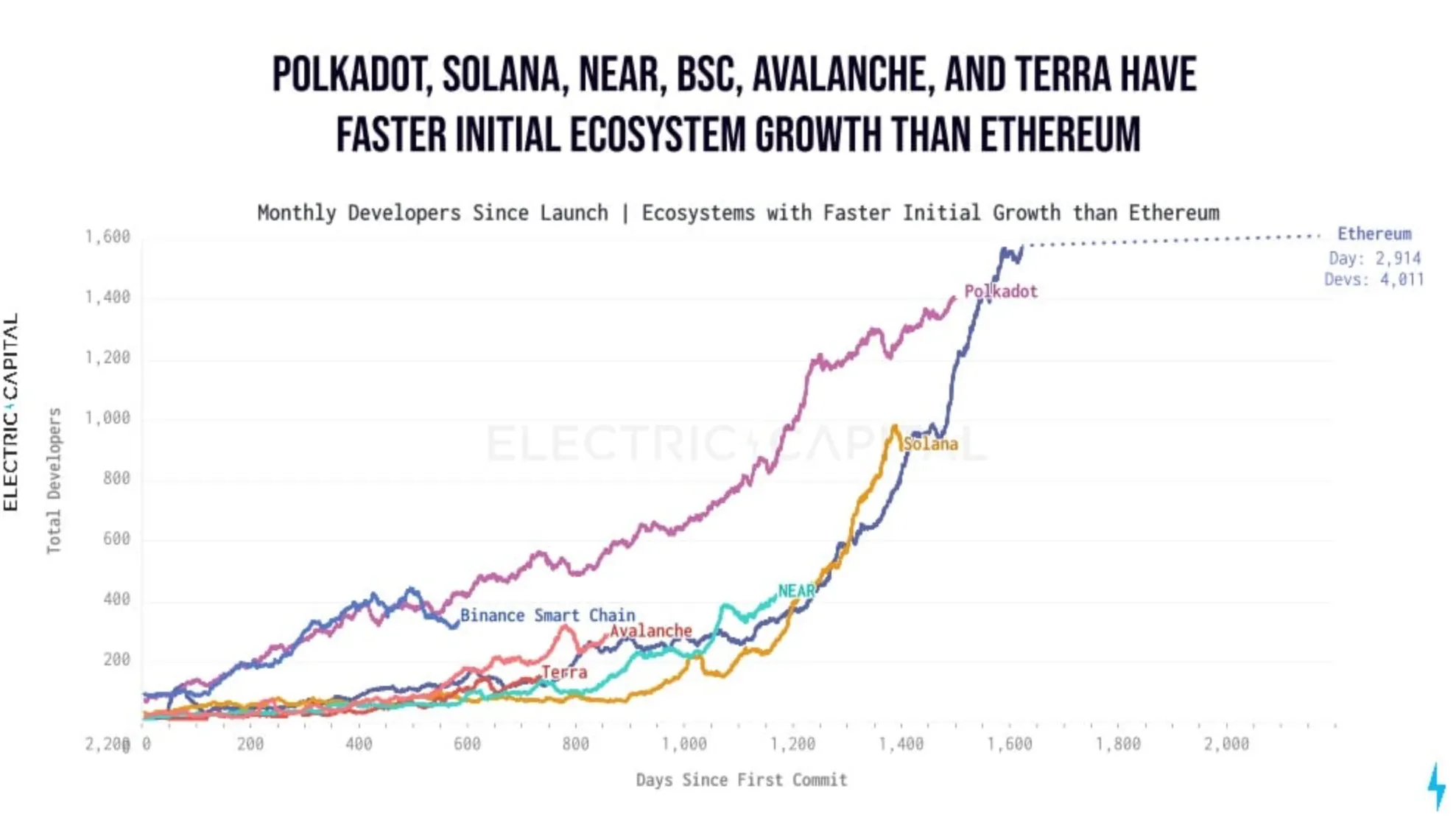In brief
- The top-five blockchain ecosystems in terms of developers are Ethereum, Polkadot, Cosmos, Solana, and Bitcoin, according to Electric Capital.
- Polkadot and Solana have more active development than Ethereum did at similar points in its history.
There's nothing like a market boom to bring people aboard. After a record 2021 for crypto prices, more developers than ever joined Web3 projects last year.
And according to a new report from early-stage crypto investment firm Electric Capital, several protocol ecosystems are outpacing the largest developer ecosystem out there, Ethereum. "Polkadot, Solana, NEAR, [Binance Smart Chain], Avalanche, and Terra have faster initial ecosystem growth than Ethereum," the report states.
The metrics it uses to come to this conclusion are the length of days since the first "commit," or change to the code, and the number of total developers since launch. When measured against Ethereum at a similar stage, those six layer-1 ecosystems have more active developers.

Solana, Avalanche, BSC, and Terra have all emerged in the past year as new hubs for decentralized finance (DeFi) activity, with their networks accommodating applications for peer-to-peer lending, swaps and other transactions. Their token prices have climbed the charts accordingly. NEAR is also integrating DeFi elements, causing its native coin to hit a record high this week. And after several years of work, Polkadot launched "parachains" at the end of December, essentially bringing smaller blockchains onto its network.
Electric Capital's lengthy report includes several elements that put ecosystem growth in perspective, lest someone cries foul that it misrepresents Ethereum's overall value while puffing up rivals.
First, it admits that "not all commits are created equal" in terms of time spent, and it limits its scope to open-source code repositories, which has the effect of undercounting total developers.
Second, the report slices developer data in multiple ways, including looking at full-time, part-time, and one-time protocol and community developers. (Protocol devs work on the core blockchain while community devs work on the tools and applications on that blockchain.) When looking at only full-time developers (those with at least 10 commits per month), Solana, Polkadot, BSC, and NEAR still rank ahead of Ethereum at comparable stages; Avalanche and Terra do not.
Third, Electric Capital also dives into retention levels across protocols and what makes devs stick around. (Hint: Those joining at the market peak aren't as likely to stay.) It finds that Ethereum draws the lion's share of new Web3 developers, averaging between 20 and 25% of the total each month. That equates to over 700 new developers for Ethereum per month, an all-time-high. Moreover, 30% of those developers who started full time on Ethereum projects in 2017 were still around in 2021. Across the entire Web3 space, retention through three years was 30%—Ethereum has lower rates of attrition.
1/ Time for @ElectricCapital's Annual Developer Report:https://t.co/aiKIJnwYdm
We analyzed 150m+ repos & xM code commits to produce these 100+ charts.
This was a community effort: 150 people contributed via email and Github! Thank you everyone who helped.
Let's dig in👇
— Avichal - Electric⚡️Capital ┻┳ (¤,¤) 🍣🦙 🐇🕳 (@avichal) January 5, 2022
Finally, there's a tacit recognition that Bitcoin and Ethereum existed in very different market environments than newer entrants such as Solana and Terra. Bull runs attract developers, per Electric Capital's findings, not the other way around. The success of Bitcoin and Ethereum through previous bull cycles helped prime the larger crypto ecosystem we're seeing today. Moreover, blockchains such as Avalanche and BSC borrowed core components of their networks from Ethereum, which have helped them attract developers familiar with the latter.
In terms of where things stand today—regardless of the blockchain's age—Ethereum still has the largest developer ecosystem, though Bitcoin has fallen to fifth, behind Polkadot, Cosmos, and Solana.

